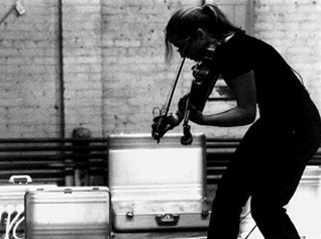 |
Appliance In the spring of 2000 sculptor
Thomas Charveriat, composer Douglas
Geers, and I embarked upon a collaborative project entitled Appliance,
an interactive performance installation for violin, electroacoustic
music, and mechanized sculptures (sound- and light-generating
electro-mechanical works mounted into aluminum suitcases). Appliance
was performed the same year at the Computer Music Center of Columbia
University and in Williamsburg, Brooklyn.
This collaborative project introduced me to a new kind of interactive performance with objects. It was my first experience wearing computerized devices and cables that captured performance data, as well as a jump into the cold waters of public improvisation with my instrument. The three of us were interested in this case to bring to life a system of possibilities rather than to create a fixed piece. Thus, each performance of this work varies in shape, content, and length. This experience led me, a classically trained musician, to change my conception of musical "choice" radically; now I was creating sound constellations myself, as if playing with a sonic kaleidoscope. In Appliance the sculptures became my chamber music partners, whom I could address separately or together. These would "talk back" in particular, semi-controllable, ways (actually, Thomas enjoys letting objects behave completely unpredictably as well - watch out!) to which I would then react with my own sound and movement, which they would react to in turn, and so forth. In performance, I wore a sensor glove to communicate with a Max/MSP patch that controlled a delay line and playback of audio samples. Meanwhile, I also operated a footswitch that controlled the activities of Thomas's sculptures, which were connected into a network. Below is a selection of details about the work. For fuller descriptions of the sculptures and Max patch used, please refer to the websites of Thomas Charveriat and Douglas Geers. The sensor glove is worn on the violinist's right (bowing) hand (Figure 1). The glove is handmade from clingy lycra with open fingertips to allow for better bow control. Three force-sensing resistor (FSRs) are sewn to the glove's index, third, and fifth fingers, which the violinist can bend or stretch while still bowing in a traditional way. An accelerometer (tracking X and Y velocities) is velcroed on the back of the hand, picking up larger movements of the violinist's right hand. Wires from the glove's sensors and the accelerometer unite at a serial connection which sends the data to a Pic Microcontroller residing in a small switchbox also worn on the violinist's hip. The chip translates data coming from the glove into MIDI control signals and sends this out to a MIDI interface and the central computer. The MIDI cable feeds into a Macintosh laptop running Max/MSP and a patch built specifically for this piece (Figure 2.) The motions of each finger are mapped to control an individual aspect of performance: delays on/off, samples on/off, and changing the currently active sample bank. The accelerometer data is mapped to control panning and amplitude. The delay time can range from 0.125 second to 5.0 seconds and is controllable from the computer, which is operated by a second performer. The amount of delay feedback is also controllable at the computer. The samples contain a mixture of violin sounds and percussive sounds. In addition to the controller glove, a small microphone is mounted on the violin and this signal is also fed into MSP. Using the Miller Puckette's fiddle~ object, we track note onsets, envelopes, and pitch. This data is used to trigger samples when the sampling function is turned on (fifth finger's FSR.) We use the MSP groove~ object for sample playback, looping short percussive samples to match violin notes' amplitude envelopes and transposing samples according to the estimation of the violin's current pitch. Each sculpture is composed of motorized elements mounted on a sheet of metal and elegantly laid into a burnished aluminum suitcase. Most of the mechanisms of the sculptures create both motion and sound. Each sculpture also contains at least one microcontroller chip, programmed in BASIC to define the behavior patterns of that sculpture. The sculptures are connected into a network to coordinate their activities. The violinist operates a MIDI footswitch to cycle though a preprogrammed pattern of behaviors of the sculptures. When activated, the mechanism of a sculpture begins to move and make noise. Each sculpture is miked, and this signal is mixed with the violin and the MSP output for amplification. |
